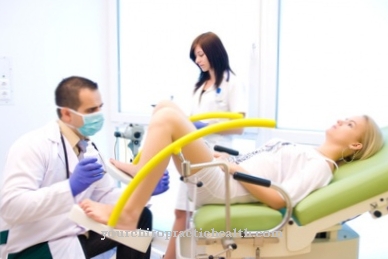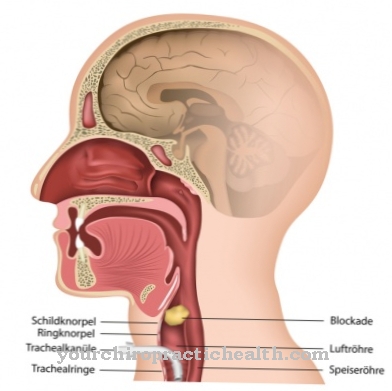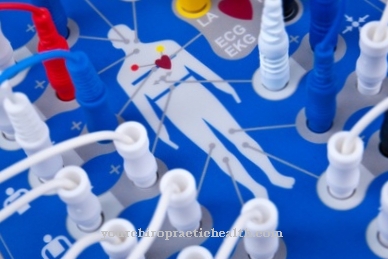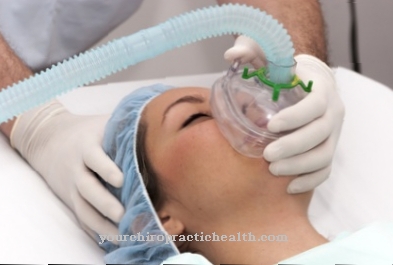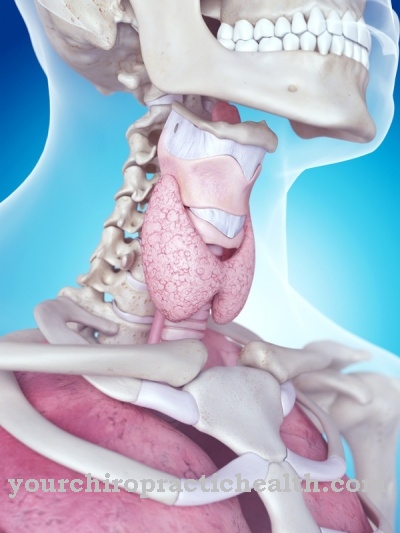The Body plethysmography is a method for determining lung function in respiratory diseases. Important respiratory physiological parameters such as breathing resistance, total lung capacity and residual volume are measured. The method is very reliable and provides more specific information on lung function than conventional spirometry.
What is body plethysmography?

Body plethysmography was introduced in clinical practice in 1956 to test lung function. Today it is considered to be the procedure of first choice in clinics and practices of lung specialists. Another name for body plethysmography is Full body plethysmography, because the tidal volume of the whole body is determined.
Plethys is the Latin expression for quantity, while the ending "-graphie" indicates graphic representation. Body plethysmography shows the amount of air inhaled and exhaled throughout the body. The capacity of the lung function provides information about its performance. Three parameters in particular are of interest for the measurement. That is the breathing resistance, the residual volume and the total lung function.
The breathing resistance represents the resistance that has to be overcome when breathing. The residual volume describes the remaining volume of air in the lungs after exhaling. The total lung capacity is characterized by different volumes such as breathing gas volumes, breathing volumes and lung volumes. With the determination of these parameters, body plethysmography can diagnose obstructive and restrictive lung diseases well.
Function, effect & goals
Body plethysmography is based on the physical law of Boyle and Mariott. Thereafter, the product of pressure and volume also remains constant at constant temperature. If the volume increases due to expansion, the pressure automatically decreases and vice versa. The measurement is carried out in an almost airtight closed cell.
A tiny air leak ensures that the increase in cabin pressure is compensated for by the patient's body temperature. When inhaling through a spirometer, the chest rises and the lung volume increases. At the same time, the volume in the cabin drops slightly, which causes a slight increase in pressure. This change in pressure caused by breathing is determined and the volume of air inhaled or exhaled is calculated from this. These data allow conclusions to be drawn about the three important parameters of breathing resistance, residual volume and total lung capacity. For example, the residual volume (residual volume after exhalation) in a healthy person is approximately 1.5 liters.
Classic spirometry provides the first evidence of a lung disease. Only the volume inhaled and exhaled is measured without taking the pressure changes into account. Residual volume and airway resistance cannot be determined with this method alone because the internal pulmonary pressure is not measured. However, this is a prerequisite for differentiating between obstructive and restrictive lung diseases. Obstructive lung diseases are characterized by narrowing or obstruction of the airways. Obstructive pulmonary diseases include such diseases as bronchial asthma, chronic bronchitis or COPD (chronic obstructive pulmonary disease).
These respiratory diseases are characterized by a blockage of the air flow. In restrictive lung diseases, the development of the lungs is hindered by scarred changes, such as in lung fibrosis or lung damage from asbestos. The normal residual volume of the lungs can no longer be achieved. With the body plethysmography, the respiratory diseases can be assigned immediately. In addition, the body plethysmography also reliably shows the severity of the lung disease. With regular measurements, the course of the disease can be followed and, if there is a dramatic change, treated quickly. The measurement is combined with spirometry. The patient sits in the cabin and breathes in and out through a spirometer. In contrast to classic spirometry, the measurement is independent of the patient's cooperation.
Breathing at rest is sufficient for the measurement. The small pressure changes in the cabin are evaluated by a computer program. The computer program also takes into account the age and gender of the patients. A sensor records the force of the breathing movements. The measured values show whether and how the lung function has changed. Above all, it can be seen whether the breathing resistance is too high (obstructive airway diseases) or the residual volume is too low (restrictive lung disease).
Although the measurement is independent of the patient's cooperation, he should still follow the doctor's instructions for inhaling and exhaling. The results are evaluated within a few seconds. An experienced pulmonologist can then diagnose the first diseases. It quickly becomes clear which other tests still need to be carried out. These are usually diffusion tests, ergospirometry and provocation tests. For the patient, body plethysmography is slightly more time-consuming than classic spirometry.
Risks, side effects & dangers
Body plethysmography does not pose a health risk. There is no exposure to radiation or pressure. The glass cabin is not locked and can be left at any time in the event of respiratory problems or panic attacks. The examination method is therefore absolutely harmless and is carried out without complications even with small children. Serious complications have hardly ever occurred.
On the contrary, body plethysmography can greatly reduce the risk of lung diseases. The course of the disease can be followed and treated with regular measurements. For many patients it would be a risk not to use this method. Another advantage is that body plethysmography can be performed without the use of force when breathing. The procedure is essential for a definitive diagnosis. However, the outlay on equipment and the acquisition costs are considerable. This also explains why body plethysmography is only performed in clinics and by specialists.

